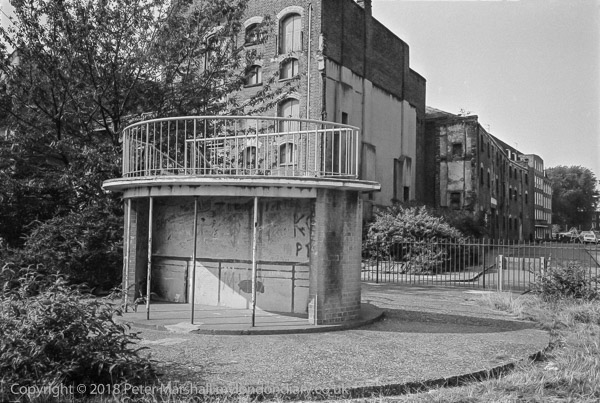London 1981
Peter MARSHALL

Dockers pulpit, Wapping, 1981
29g-31:,street, shelter, viewpoint, Tower Hamlets,
You can click on the image to go to the next picture
I asked one of the old men who sat in the park looking out across the river about this structure; he was a former docker ande told me it was the "docker's pulpit" where union leaders addressed large crowds of workers.
The park, Waterside Gardens, is still there, off Wapping High St opposite Reardon Path, but this structure is long gone, probably demolished when the gardens were enlarged around 1989. There is now just a small decorative gazebo which might provide a little shelter from rain.
The building behind has been replaced by an uglier modern building which goes right to the edge of Reardon Path (in the 1890s Red Lion St), while the derelict range further down the path was converted in 2018 into Red Lion Court, 'Luxury Warehouse Apartments and Penthouses'. Further down the street, Willoughby House, the first of a number of council blocks built by the LCC with the Commercial Gas Company as a part of their 1926 Wapping Housing Estate slum clearance scheme.
The gas company as well as laying pipes and installing meters, also fitted 824 cookers, 138 heaters, 324 brackets and a number of gas coppers. The brackets were presumably for gas lighting and the coppers to boil your washing. We had one in the kitchen at home when I was a boy, along with a mangle outside and a washing line down the garden path. The Wapping flats had "excellent facilities for drying the household washing", lines outside in tar-paved couartyards, and there were also "a number of flower beds, interspersed with patches of green turf".
Willoughby House was one of 12 blocks containing altogether 824 flats. Each block was named after a famous explorer who sailed from the area. According to material from Tower Hamlets Local History Archive put on-line by Harry Mernick originally published in 1932 in "The Copartnership Herald:
'Sir Hugh Willoughby was appointed captain of a fleet of three ships, which set out in 1553, with the object of discovering a north-eastern passage to Cathay and India. Two of the three ships reached the coast of Lapland, where it was proposed to winter. Soon after January, 1554, Willoughby and his companions died of starvation, and a few years later their remains were found, together with Willoughby's Journal, which is printed in the first volume of Richard Hakluyt's famous Principal Navigations.'
The park, Waterside Gardens, is still there, off Wapping High St opposite Reardon Path, but this structure is long gone, probably demolished when the gardens were enlarged around 1989. There is now just a small decorative gazebo which might provide a little shelter from rain.
The building behind has been replaced by an uglier modern building which goes right to the edge of Reardon Path (in the 1890s Red Lion St), while the derelict range further down the path was converted in 2018 into Red Lion Court, 'Luxury Warehouse Apartments and Penthouses'. Further down the street, Willoughby House, the first of a number of council blocks built by the LCC with the Commercial Gas Company as a part of their 1926 Wapping Housing Estate slum clearance scheme.
The gas company as well as laying pipes and installing meters, also fitted 824 cookers, 138 heaters, 324 brackets and a number of gas coppers. The brackets were presumably for gas lighting and the coppers to boil your washing. We had one in the kitchen at home when I was a boy, along with a mangle outside and a washing line down the garden path. The Wapping flats had "excellent facilities for drying the household washing", lines outside in tar-paved couartyards, and there were also "a number of flower beds, interspersed with patches of green turf".
Willoughby House was one of 12 blocks containing altogether 824 flats. Each block was named after a famous explorer who sailed from the area. According to material from Tower Hamlets Local History Archive put on-line by Harry Mernick originally published in 1932 in "The Copartnership Herald:
'Sir Hugh Willoughby was appointed captain of a fleet of three ships, which set out in 1553, with the object of discovering a north-eastern passage to Cathay and India. Two of the three ships reached the coast of Lapland, where it was proposed to winter. Soon after January, 1554, Willoughby and his companions died of starvation, and a few years later their remains were found, together with Willoughby's Journal, which is printed in the first volume of Richard Hakluyt's famous Principal Navigations.'